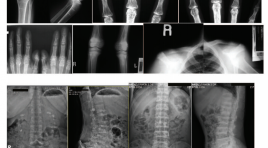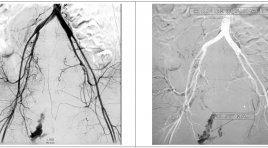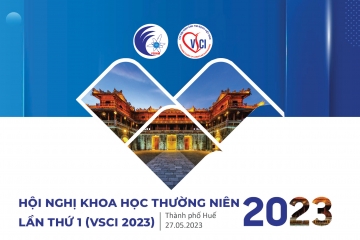
Nghiên cứu kết quả điều trị tăng sản lành tính tuyến tiền liệt thể lồi vào bàng quang bằng phương pháp nút mạch
06/05/2021 14:23:09 | 0 binh luận
SUMMARY Objective : To acess the results of prostatic artery embolization (PAE) in patients wwith significant intravesical prostatic protrusion (IPP). Material and methods: Prospective analysis of 45 consecutive patients with significant IPP undergoing PAE. We measured IPP on sagittal T2-weighted images before and after PAE. IPSS and clinical results were also evaluated before and after PAE. Results: PAE resulted in significant IPP reduction (16.9 ± 7.9mm before PAE and 13.2 ± 6.6mm after PAE, p < 0.001) (Fig. 1) with no complication. IPSS, quality of life (QoL), total prostate-specific antigen (PSA) level, and prostate volume (PV) showed significant reduction after PAE, and maximum urinary flow rate (Qmax) showed significant increase after PAE. A significant correlation was found between the IPP change and the IPSS change (r = 0.628, p = 0.001). Conclusion : Patients had significant IPP reduction as well as significant symptomatic improvement after PAE, and these improvements were positively correlated. Keywords: Benign prostate hyperplasia, Intravesical prostatic protrusion, Prostate artery embolization (PAE)

Khảo sát giá trị của các số đo đậm độ trên chụp cắt lớp vi tính trong chẩn đoán adenoma tuyến thượng thận
05/05/2021 17:03:06 | 0 binh luận
SUMMARY: Objective: To describe the characteristics of common adrenal lesions on CT and to compare the diagnostic performance of different methods of measurement in diagnosing adenoma. Materials and Methods: We conducted a retrospective study in 63 patients with adrenal lesions who were performed preoperative CT and had histologic results at the University Medical Center Hospital between January 2016 and January 2020. A radiologist who had more than 10 years of experience of CT measured: lesion size, mean and standard deviation (SD) attenuation value, pixel histogram, calculated p10 based on histogram or following formula P10=mean – (1,282 x SD). The diagnostic performance of mean value, histogram analysis, calculated p10, absoulte and relative washout index were compared. Results: The study was composed of 32 patients with 32 adenomas and 31 patients with 33 non-adenoma lesions. Adenomas were more common in female (n = 26 [81.3%]) than in male patients. However, non-adenoma were almost equally distributed between male and female patients (n = 15 female patients [48. 4%]). The mean age of patients in the adenoma group was 44.3 ± 12.6 years (range, 12-75 years), which is not significantly different from the mean age of 41.2 ± 15.1 years for patients in the non-adenoma group (range, 13-77 years) (p = 0.26). Adenoma group had the mean diameter smaller than non-adenoma lesions (p <0,001) and more homogeneous attenuation pattern (p=0.001). The sensitivity, specificity and accuracy of the mean attenuation analysis, histogram, calculated p10, absoulte and relative washout were (37.5%, 100.0% and 66.7%, cutoff 10 HU), (84.4 %, 82.8% and 83.6%, cutoff 10%), (78.1 %, 82.1% and 80%, cutoff 0), (88 %, 72% and 80%, cutoff 60%), and (84.0 %, 65.4% and 74.5%, cutoff 40%), respectively. Conclusion: The mean attenuation analysis, histogram and calculated p10 play a crucial role in differentiation adrenal adenoma from non-adenoma lesion. The accuracy of histogram analysis and calculated 10th percentile outperformed the mean attenuation as a diag-nostic criterion for adenoma. Keywords: adrenal gland, adenoma, computed tomography

Siêu âm chẩn đoán bệnh lý cường tuyến cận giáp nguyên phát: nhân 26 trường hợp được phát hiện tại hệ thống y khoa medic TPHCM và Cần Thơ
02/06/2020 09:26:46 | 0 binh luận
SUMMARY Primary hyperparathyroidism is a rare disease, difficult to diagnose early due to non specific clinical findings. The radiographic signs often misinterpreted. X-ray signs often show a condition of osterosporosis, fractures or urinary tract stones. Biochemical examination are still insufficient at some hospital, so a majority of cases were detected too late with severe skeletal sequelae, and sometimes irreversible. Retrospective study of 26 cases diagnosed at Medic Medical system and follow-up after treatment, we observed that: - 26 Patients: 8 Man (31%) 18 Female (69%), 15YO-54YO, Average:38.5YO - Clinical symtoms are often nonspecific, often showing pathology of the skeletal system 92%, urinary stones : 46%, digestive tract: 77%- 85%. - Radiographic skeletal specific sign of of osterosporosis77% , fractures 42%, Osteolytic 52% or urinary tract stones.46%. suggest diagnosing hyperparathyroidism. - PTH (Parathyroid hormone) value are elevated in 100% of cases. - Neck ultrasound: 100% of patients (26/26) have parathyroid adenoma, most on one side of the lower lobe is the main cause of hyperparathyroidism. - Primary hyperparathyroidism are radically cured by surgically removal of the adenoma, so the early diagnosis of this

Đặc điểm lâm sàng, giải phẩu bệnh, siêu âm bệnh nhân u tuyến thượng thận đã phẩu thuật tại bệnh viện chợ rẫy năm 2014 - 2015
13/04/2020 15:25:10 | 0 binh luận
Clinical, pathology, ultrasound in patients with adrenal tumors, had surgery in Choray Hospita SUMMARY Objectives : Clinical, pathology, ultrasound in patients with adrenal tumors. Methods: Retrospective - Described a case series Results : 1/2014-6/2015, 84 patients. Pathology: 34 (40.5%) adrenocortical adenomas and 23 (27.4%) pheochromocytoma,. Clinical: Group of patients without clinical symptoms 57 (67.9% Utrasound : adrenal tumor in the left/right # 1, tumors 50.52 ± 27,19mm mix-echo 41.7% 47.6% hypoechoic, clearly limited tumor (casings unknown) 91.7%. Ultrasound correctly identified 97.6% of adrenal tumors. Conclusions: Ultrasonography correctly identify and detect adrenal tumors accidental high percentage. Key words :Adrenal tumor, Ultrasound.

Nghiên cứu đặc điểm giải phẫu, biến thể của động mạch tuyến tiền liệt trên chụp mạch số hóa xóa nền
06/04/2020 21:18:37 | 0 binh luận
Studying anatomical characteristics and variants of prostatic artery on digital subtraction angiography SUMMARY Objectives : To describe anatomical features and variants of prostatic artery (PA) on digital subtraction angiography (DSA). Subjects and Methods: Descriptive statistic study. We reviewed the DSA of 58 patients, which had a PA embolization to reduce the benign prostatic hyperplasia (BPH) symptoms at radiology department of Bach Mai Hospitalfrom Oct - 2016 to June - 2017 Results: PA was found at 110 pelvic halves, of which 5 pelvic halves (4,5%) had two PAs, 105 pelvic halves had one PA. In terms of the type of origin of PA according to Francisco Carnevalle, in 115 PAs, the percentage of type 1 (was from a common trunk with the superior vesical artery - SVA), type 2 (anterior division of internal iliac artery), type 3 (obturator artery), type 4 (internal pudendal artery), type 5 (less common origins)was successively 33,9%, 13,9%, 18,3%, 23,9%, 10,4%. Atherosclerosis of PA observed in 20.9%.The “corkscrew” patern was found in 30.4%. The average diameter of PA was 1.5 ± 0.34mm. Anastomosis of PA with surrounding arteriesare common. PA may supply rectum (6.1%), seminal vesical(9.6%), bladder (5,2%), controlateral prostatic parenhyma (13%), surrounding soft - tissues (3.5%). Conclusion : The common trunk with SVA was the most common origin of PA. Anatomosis of PA with surrounding tissues is complex.... Therefore, profound knowledge ofthe PA anatomy and variants on DSA is necessary to treat BPH by prostatic arterial embolization. Key words: prostatic artery, digital subtraction angiography, Francisco Carnevalle classification.

Đánh giá các thương tổn dạng nốt tuyến giáp theo phân độ TIRADS 2017
30/03/2020 22:45:43 | 0 binh luận
Research value of ultrasonographic and TIRADS 2017 classification as ACR (American College of Radiology) SUMMARY Purposes : Describe imaging characteristics and stratify TIRADS 2017 as ACR. Materials and methods : There are 259 consecutive patients with thyroid nodules on ultrasound. All of them were undergone operation with pathology after surgery. Results : The average age is 42,8 ± 12,2 years old and female/ male=10/1. Histopathology results after surgery, thyroid cancer 9,3%. The solitary nodules are the highest ratio (65,8%). Most lesions are over 25 mm in size. TIRADS 3 is the highest (40,2%) and the least is TIRADS 2 accounts for 0,4 %. TIRADS 2017 classification and pathology indicates strong evidence with p < 0,05. Conclusion :TIRADS 3 is the highest (40,2%) and TIRADS 2017 classification and pathology indicates strong evidence with p < 0,05. Key word: Thyroid nodule, TIRADS classification

Chảy máu sau đẻ do tổn thương động mạch thẹn trong nguyên nhân hiếm gặp: báo cáo nhân 1 trường hợp
01/04/2020 14:18:39 | 0 binh luận
SUMMARY A secondary postpartum hemorrhage may occur between 24 hours and 6 weeks after the birth. Secondary postpartum hemorrhage may be caused by endometritis, damage to an artery in caesarean, possible as a result of abscess from puerperal infection that causes damage to blood vessel. The urterine artery lesion is the most common, the internal pudental artery lesion is very rare. We report a case of a 36 year old patient, bleeding 12 days in postpartum due to damage to the internal pudendal artery, successful embolization of the internal pudendal artery. Keyword: Secondary postpartum hemorrhage, embolization, uterine artery, internal pudendal artery.

Khảo sát sự tương quan giữa sa trực tràng dạng túi với các bệnh lý sàn chậu thường gặp khác
31/03/2020 19:27:58 | 0 binh luận
Investigation of the relationship between rectocele and other pelvic floor disorders SUMMARY Background - Objectives: Pelvic floor dysfunction and prolapse are common condition of women past the middle age, with nonspecific clinical symptoms. Many cases of rectocele occurs combine with other pelvic floor disorders. Failure to recognize the complex set of pelvic floor defects leads to most therapy failures. The aim of this study is order to evaluate the correlations between age, number of birth and rectocele, and to define the role of dynamic magnetic resonance defecography in diagnosis. Methods : Cross-study description. Patients with pelvic floor dysfunction had done clinical examinations and they were indicated dynamic MR Defecography at University Medical Center, HCM City by urologist or gynecologist and proctologist. Results: MR Defecography of 1683 patients was evaluated from 01/2008 to 6/2012. Most patients are about 40 to 50 years old with 2 to 3 parity. 1218 patients with incontinence; 1311 patients (77.9%) has rectocele. Prolapse of the posterior compartment is the most common type of prolapse. Rectocele combines with more than one pelvic organ prolapse 77.4%; 64.2% of the patients with anismus had rectocele. There are statistically significant in the correlation of age, the number of birth with rectocele or pelvic organ prolapse (OR # 1.04-2.67 and p<0.005). Risk of rectocele was higher in the patients with pelvic organ prolapse than in the patients without pelvic organ prolapse (p<0.005). Conclusions: Complex pelvic floor disorders often involve several compartments. Dynamic MR Defecography allows evaluating the both morphological and functional assessment of the pelvic floor, selecting the most appropriate treatment.
Bạn Đọc Quan tâm
- Ca lâm sàng: điều trị ung thư tuyến giáp bằng I-131
- Những tiến bộ trong chẩn đoán hình ảnh bệnh tim – mạch
- Ứng dụng CNTT trong chẩn đoán hình ảnh giúp tăng chất lượng y tế
- CA LÂM SÀNG: UNG THƯ BIỂU MÔ NỘI ỐNG TUYẾN VÚ
- KẾT QUẢ ỨNG DỤNG XẠ HÌNH THẬN ĐỘNG TẠI BỆNH VIỆN NHI ĐỒNG THÀNH PHỐ
- NGHIÊN CỨU BƯỚC ĐẦU ĐÁNH GIÁ VAI TRÒ CỦA TRÍ TUỆ NHÂN TẠO TRONG PHÂN TÍCH KẾT QUẢ X QUANG NGỰC THẲNG TẠI BỆNH VIỆN CHỢ RẪY
- NGHIÊN CỨU ĐẶC ĐIỂM HÌNH ẢNH VÀ VAI TRÒ CỦA SIÊU ÂM TRONG CHẨN ĐOÁN U TUYẾN CẬN GIÁP
- ĐÁNH GIÁ KẾT QUẢ BƯỚC ĐẦU ĐIỀU TRỊ TĂNG SẢN LÀNH TÍNH TUYẾN TIỀN LIỆT CÓ BÍ TIỂU CẤP BẰNG PHƯƠNG PHÁP CAN THIỆP NÚT ĐỘNG MẠCH TUYẾN TIỀN LIỆT
- VỠ TÚI GIẢ PHÌNH KHỔNG LỒ TÂM THẤT TRÁI: BÁO CÁO 1 TRƯỜNG HỢP HIẾM GẶP TẠI BỆNH VIỆN BẠCH MAI
- VAI TRÒ CỦA SINH THIẾT BẰNG KIM LÕI DƯỚI HƯỚNG DẪN SIÊU ÂM TRONG ĐÁNH GIÁ HẠCH CỔ BẤT THƯỜNG
Sự kiện sắp diễn ra
Thông tin đào tạo
- Những cạm bẫy trong CĐHA vú và vai trò của trí tuệ nhân tạo
- Hội thảo trực tuyến "Cắt lớp vi tính đếm Photon: từ lý thuyết tới thực tiễn lâm sàng”
- CHƯƠNG TRÌNH ĐÀO TẠO LIÊN TỤC VỀ HÌNH ẢNH HỌC THẦN KINH: BÀI 3: U não trong trục
- Danh sách học viên đạt chứng chỉ CME khóa học "Cập nhật RSNA 2021: Công nghệ mới trong Kỷ nguyên mới"
- Danh sách học viên đạt chứng chỉ CME khóa học "Đánh giá chức năng thất phải trên siêu âm đánh dấu mô cơ tim"











